The featured snippet is a much sought-after ranking in the search engine results pages because it typically appears the highest and can increase your website’s visibility.
Google displays featured snippets in a special answer box that appears above the regular search results. It contains a basic answer to the user’s search queries and a link to the website where they can find more information.
This post will discuss featured snippets, the different types, and how you can optimize your content to appear in them.
What is a Featured Snippet?
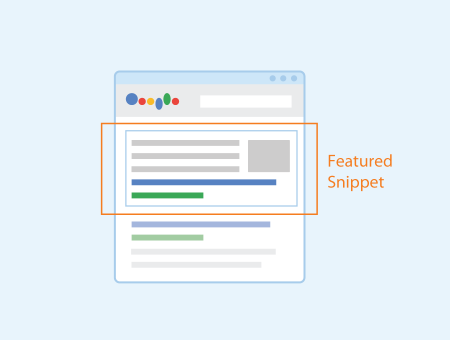
A featured snippet is a Google algorithm to surface content from web pages on the organic search results page. Featured snippets take place above the regular search results. This algorithm looks for certain types of content, such as headings, lists, and tables.
The featured snippet gives users quick and easy access to crucial information from a web page. Featured Snippets are a subset of rich snippets and are a great way to see your website by more people, leading to increased click-through rates and organic traffic.
Types of Featured Snippets
There are different types of Google featured snippets, but the most common are definitions, tables, numbered/ordered lists, and unordered lists.
1. Definition
Definition featured snippets are a brief, one-sentence definition that answers the query of the definition straight away.
Definition featured snippets increase your CTR, giving users a quick and easy way to learn more about your page.
It is best to use definition featured snippets when your page is a good match for the user’s search queries.
If your page is not a good match, you may consider using another type of featured snippet.
The alternative to this is to create a whole new page specifically targeted to rank and steal this featured snippet position.
If a user searches for “SEO”, a definition featured snippet might appear like this:
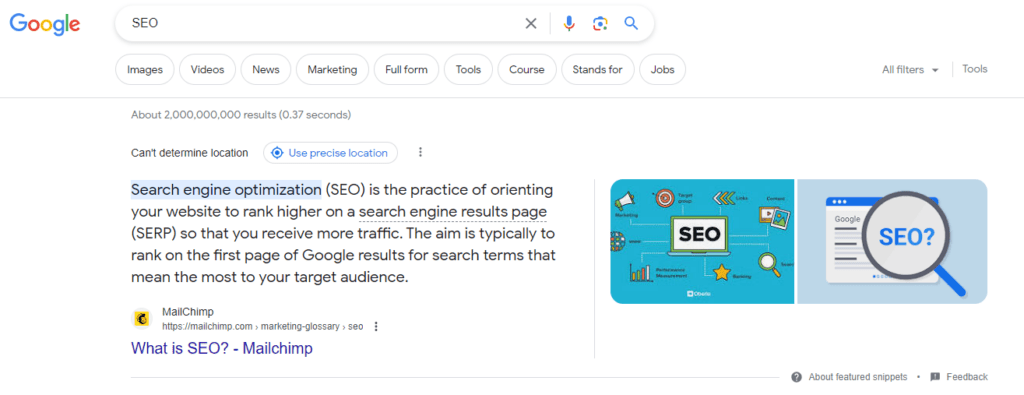
This snippet quickly answers the user’s query and can increase the click-through rate (CTR) to your page if it provides valuable and targeted content on SEO.
2. Table
The table featured snippets are ideal for when you want to compare a few different pieces of information quickly.
It is one of the types of featured snippets that is best to use when you have data that you can readily display in a table format. Table snippets include things like prices, sizes, specs, or nutritional information.
If a user searches for “conversions metric to English”, a table featured snippet might appear like this:
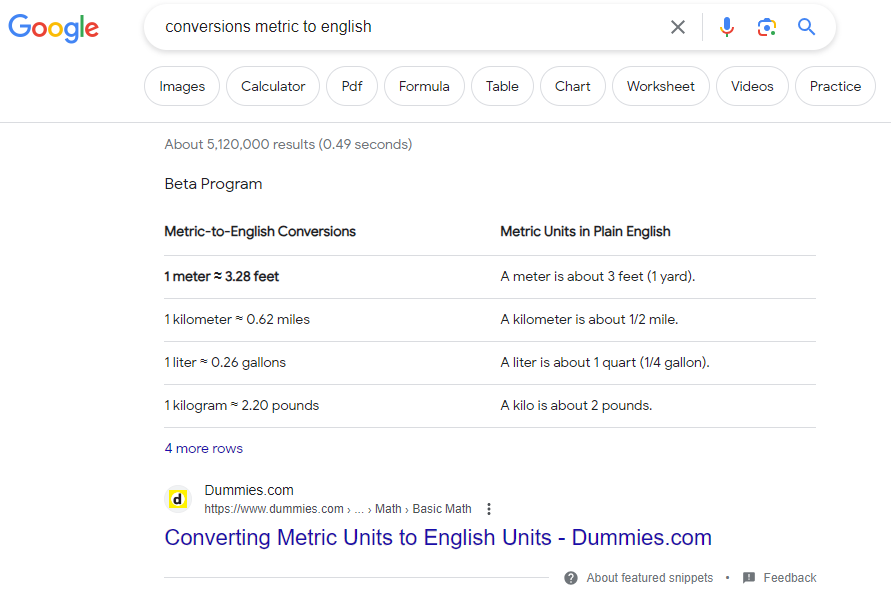
As you can see, the table featured snippet allows users to quickly compare different conversion metrics and find the information they need without having to click through multiple pages.
3. Numbered/Ordered List
Numbered/Ordered List featured snippets are what they sound like. Google will display featured snippets as a numbered list, often with some additional information about each item on the list.
Using number/ordered list featured snippets is best when your content is a list of items, steps, or instructions.
If your content is not already in list format, you may need to reformat it to take advantage of this type of featured snippet.
For example, if a user searches for “how to calm yourself”, a numbered/ordered list featured snippet might appear like this:
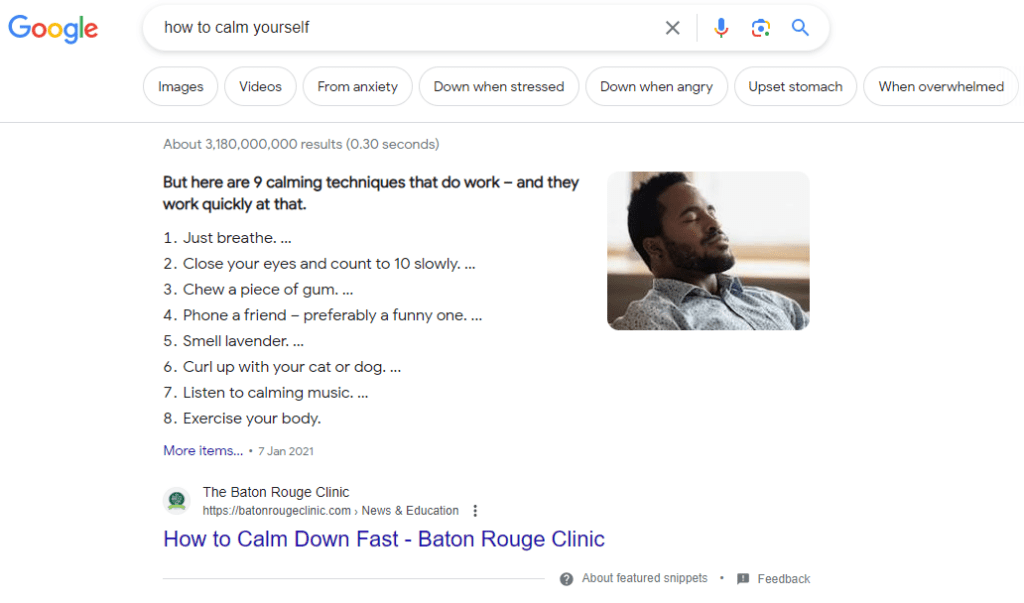
4. Unordered List
An unordered list is one of the types of featured snippets that does not matter the order of the items.
For example, a recipe might use an unordered list to list the ingredients needed to make the dish. Using listicle-featured snippets is best when you want to list ideas, steps, or ingredients.
However, if a list of completed items should be in a specific order, then an ordered list would be more appropriate.
For example, if a user searches “pancake recipe without baking powder”, a numbered/ordered list featured snippet might appear like this:
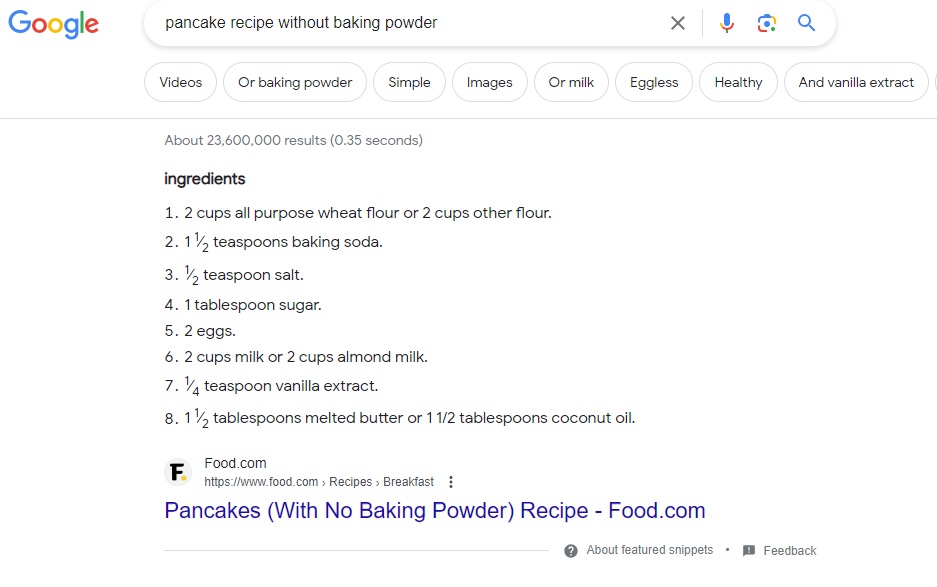
5. Video
Video featured snippets are becoming increasingly popular as more users prefer visual content. These snippets display a short clip from a video content that directly answers a user’s query. This type of snippet is best utilised when your content is in video format and clearly answers specific questions or demonstrates a process.
As an example, if a user searches for “how to tie a tie”, a video featured snippet might appear, showing a brief clip from a video tutorial on tie-tying. In this clip of video snippet, a person would be seen demonstrating the different stages of tying a tie, making it easier for the user to understand and follow the process.

Why do Featured Snippets Matter for SEO?
Featured snippets matter for SEO because they can significantly impact a website’s visibility, click-through rates (CTR), authority, and trust. Here are the benefits of achieving a featured snippet placement in Google search results:
Increased Visibility: Featured snippets appear at the top of the search results, providing greater visibility for the content. According to SEM Rush, featured snippets tend to take up 50% or more of the screen on mobile devices.
Higher Click-Through Rates (CTR): Owning a featured snippet can increase CTR by more than 850%, driving more traffic to the website and consumers into the sales funnel. Ahrefs’ study showed that a featured snippet gets approximately 8% of all clicks, and it can give the organic CTR a serious boost.
Authority and Trust: Being featured in a snippet can enhance the perceived authority of a website and its content. It shows that the website provides instant answers and is an expert in the subject matter, which can help guide people along the buyer’s journey faster.
How Can I Optimize My Content for Featured Snippets?
To trigger featured snippets, you can optimize your content to increase the chances. There are key strategies for your content to optimize for featured snippets, ultimately driving more traffic to your site.
Keyword Research
Keyword research determines the terms and phrases potential visitors might use when searching for the content you provide. Through keyword research, you can uncover opportunities for target keywords to create and optimise content that answers users’ queries, increasing your chances of being selected for a featured snippet.
You can look into long-tail keywords and question-based queries. Long-tail keywords are more specific, and while they may have a lower monthly search volume, they can help you reach a more targeted audience and increase the likelihood of your content appearing in a featured snippet.
Similarly, question-based search queries are a goldmine for featured snippets as they directly correspond to the searcher’s intent. Crafting content that answers these questions concisely and effectively can place you in the prime position in Google’s search results.
Content Structuring
Breaking up your content into concise, bite-sized chunks that are easily scannable and digestible for readers can make it more likely for Google to use it in a featured snippet.
Headings and subheadings play a crucial role in organizing your content. By using H1, H2, H3 tags, you can help Google understand the hierarchy and importance of your content. This makes it easier for the search engine to pull relevant snippets from your content and display them in featured snippets.
Moreover, incorporating lists, tables, and other visual aids can also enhance your chances of getting featured. These elements make it easier for users to quickly find the information they are looking for, and the search engine may use them in featured snippets to provide a better user experience.
On-Page SEO
On-page SEO techniques, such as optimizing meta tags, headers, and schema markup, can also help boost your chances of earning featured snippets.
Meta tags provide information about the content on your webpage to search engines. By including relevant keywords in your title tag and meta description, you can improve the visibility of your page and increase its chances of appearing in featured snippets.
High-Quality Multimedia
Incorporating your content with high-quality images and videos can significantly enhance its appeal for featured snippets. Visual elements not only break up text-heavy pages, making them more user-friendly, but they also cater to different learning styles.
Rich media such as infographics can condense complex information into easy-to-understand visuals, increasing the chance of capturing and retaining reader attention. Videos, on the other hand, can provide an immersive, engaging experience. They are especially useful for tutorials, demonstrations, or when telling a story.
Search engines like Google also recognize the value of high-quality visuals. In fact, images and videos are often featured in Google search results, making your content more noticeable and attractive to users.
How To Track Featured Snippets?
To track featured snippets, you can use various tools and methods. Here are some options:
Featured Snippet Tracking Tools: There are several tools available for tracking featured snippets, such as Semrush, Ahrefs, and Rank Ranger. These tools allow you to monitor your ranking and find opportunities to improve your content strategy.
Manual Approach: If you prefer a free approach, you can manually track your featured snippet rankings. This may involve typing your keywords directly into Google to see if they trigger a snippet. However, for a more comprehensive view, an SEO research tool is recommended.
Create a Featured Snippet Report: Once you have determined your preferred method for tracking featured snippets, you can create a featured snippet report. This can be done using tools like the Semrush API for a partially automated approach or Google Looker Studio for a free option.
What is the Difference Between Featured Snippets and Rich Snippets?
A rich snippet is an enhanced organic search result that provides extra details about a webpage, such as ratings, images, and prices. On the other hand, a featured snippet is an answer to a user’s search query that appears above the organic search results.
Can Featured Snippets Change Over Time?
Yes, featured snippets can change over time. Google is constantly testing and making changes to its algorithms, which can affect the appearance and content of featured snippets. Additionally, the metrics on featured snippet engagement are changing as well. Appearing in a featured snippet is not permanent, and there will be ups and downs, and ranking and impressions may go down as featured snippets change. If you own featured snippets for important keywords, you potentially could see your traffic reduced, as clicks could go to competing pages.
Summary
Featured snippets are not just about gaining immediate visibility; they’re a testament to your website’s authority and relevance.
By focusing on providing concise, clear, and valuable answers to users’ queries, you’re not just aiming for a spot in the snippets; you’re building a foundation for long-term digital success.
As the digital landscape continues to evolve, those who adapt and refine their strategies will find themselves ahead in the race for online prominence.









